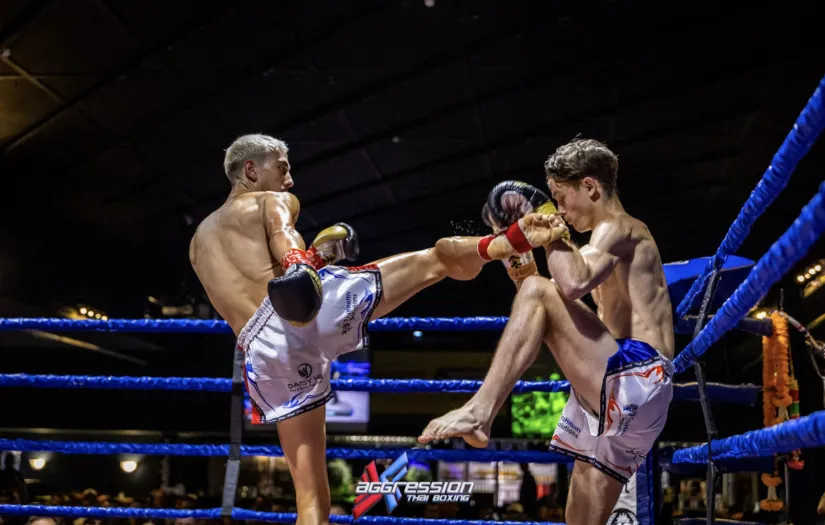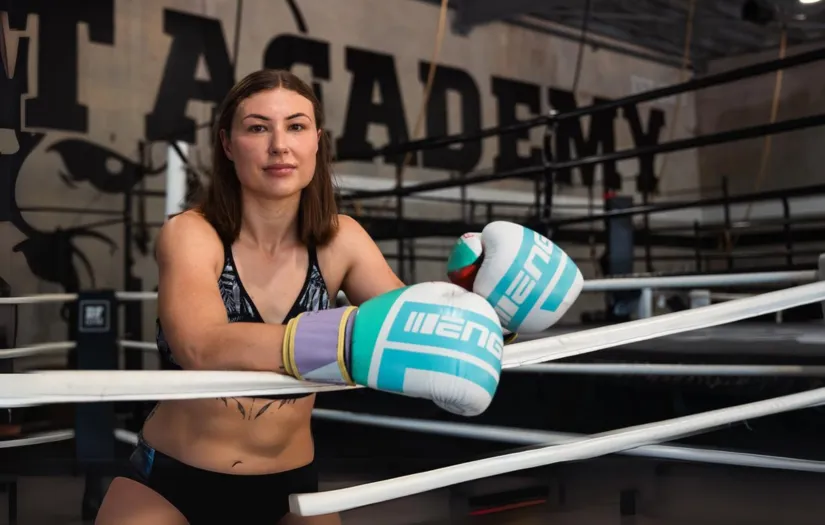
Transform Your MMA Game: Core Flexibility Workouts for Fighters
Transform Your MMA Game: Core Flexibility Workouts for Fighters
Are you struggling to improve your MMA performance due to limited core flexibility? Core strength and flexibility are essential for effective strikes, kicks, and overall agility in the octagon. This guide offers key workouts to enhance your core flexibility, focusing on preventing overtraining injuries through proper soft tissue therapy techniques. You'll learn how to integrate flexibility training into your daily routine, using tools like therapy balls to target problem areas. By the end, you'll have practical strategies to boost your performance and reduce the risk of injury.
Strengthen Your Core With Essential MMA Workouts

Core strength is crucial for MMA fighters, enhancing stability and power during fight-camps and fights. Plank variations build a solid foundation, while Russian twists target rotational strength. These exercises complement other training elements like bench press, biceps workouts, and sprints, improving overall flexibility and performance in the octagon.
Build Stability Using Plank Variations Daily
Incorporating plank variations into daily fight-camps training routines builds essential stability for MMA fighters. These exercises target the core muscles, including the abdomen and lower back, improving overall balance and control during fights. By maintaining proper form and gradually increasing duration, fighters can enhance their ability to resist motion and maintain a strong defensive posture.
Fighters should focus on maintaining a neutral spine and engaging the core throughout each Sports Strength and Conditioning variation. The goal is to build endurance and strength, allowing for better control during grappling and striking exchanges. Advanced variations, such as fight-camps and dynamic planks, challenge the core in different planes of motion, preparing fighters for the unpredictable nature of MMA competition.
Enhance Power With Russian Twist Exercises
Russian twist exercises enhance rotational power for MMA fighters, complementing traditional fight-camps movements like Sports Strength and Conditioning deadlifts and plyometrics. By incorporating a dumbbell or medicine ball, athletes can progressively overload their core muscles, developing the explosive twisting motion crucial for powerful strikes and takedowns.
To maximize benefits, fighters should focus on proper form and gradually increase repetitions and weight. This Sports Strength and Conditioning exercise, from fight-camps, targets obliques and transverse abdominis, improving overall core stability and mass. When combined with a comprehensive strength program, Russian twists from fight-camps contribute to a well-rounded fighter physique capable of generating and transferring power effectively in the cage.
Increase Flexibility for Effective Kicks and Strikes

Flexibility is crucial for MMA fighters, enabling powerful kicks and strikes in combat sports like karate. Dynamic stretching enhances mobility, preparing the body for explosive movements. Incorporating fight-camps yoga poses into training routines improves overall flexibility, allowing fighters to generate more force and maintain better control during fights. These techniques complement Sports Strength and Conditioning on machines and forearm exercises, creating a well-rounded fighter. Book a Call to learn more about our approach to training.
Practice Dynamic Stretching to Improve Mobility
Dynamic stretching improves mobility for MMA fighters, enhancing their ability to execute effective kicks and strikes fight-camps. By incorporating dynamic movements that mimic fight techniques, athletes can increase their range of motion and prepare their muscles for high-intensity training Sports Strength and Conditioning. This approach complements strength training routines, allowing fighters to maintain flexibility while building power in their hands, elbows, and core.
Fighters should perform dynamic stretches with increasing frequency as they approach fight-camps, focusing on key areas such as the hips, shoulders, and spine. These exercises can be integrated into warm-up routines, using tools like medicine balls to add resistance and improve overall muscular coordination. By consistently practicing dynamic stretching, MMA athletes can significantly enhance their performance and reduce the risk of injury during training and Sports Strength and Conditioning fights.
Incorporate Yoga Poses Into Your Training Routine
Incorporating yoga poses into MMA training routines enhances flexibility and core stability, essential for executing effective kicks and strikes. Fighters can integrate poses such as the Warrior series and the Triangle pose to improve balance and muscle control, particularly beneficial for grappling situations. These exercises also promote relaxation and recovery, complementing the intense physical demands of fight-camps and other strength training exercises.
Regular practice of yoga poses helps fighters develop better body awareness and breathing techniques, which translate directly to improved performance in the octagon. Poses like Downward Dog and Cobra stretch the entire body, reducing muscle tension and increasing range of motion. When combined with fight-camps massage, yoga can significantly accelerate recovery and prevent injuries, allowing fighters to maintain a consistent and rigorous training schedule.
Improve Balance and Agility Through Core Training

Core training enhances balance and agility for MMA fighters, crucial for managing stress and increasing speed in the octagon. Single-leg exercises improve stability, while balance boards challenge the core, engaging multiple muscle groups simultaneously. These techniques, rooted in sports medicine and physiology principles, complement Sports Strength and Conditioning exercises like the overhead press, contributing to a well-rounded fighter's physique and performance.
Add Single-Leg Exercises for Enhanced Stability
Single-leg exercises enhance stability for MMA fighters, improving balance and core strength essential for combat. These Sports Strength and Conditioning exercises challenge the body's proprioception, promoting better muscle adaptation and control. Incorporating movements like single-leg deadlifts or pistol squats while holding a sandbag or medicine ball intensifies the workout, engaging multiple muscle groups simultaneously.
Fighters can integrate single-leg Sports Strength and Conditioning exercises into their training routine, alternating between legs to ensure balanced development. These movements mimic the dynamic nature of MMA, where fighters often need to maintain stability on one leg while striking or defending. By focusing on controlled muscle contractions during these exercises, athletes can enhance their overall performance and reduce the risk of injuries in the octagon.
Utilize Balance Boards to Challenge Your Core
Balance boards challenge a fighter's core stability, enhancing their range of motion and rotational capabilities. By incorporating Sports Strength and Conditioning tools like fight-camps into training routines, MMA athletes develop greater proprioception and muscle control, crucial for maintaining balance during dynamic movements. Fighters can perform exercises like squats or push-ups on balance boards to intensify core engagement and improve overall stability.
Progressive training with balance boards can lead to significant improvements in a fighter's performance at fight-camps. Athletes can start with basic balancing exercises and gradually increase difficulty by adding weight or incorporating barbell movements. This approach not only strengthens the core but also improves cardiovascular health, as the heart works harder to maintain balance and stability during these challenging exercises.
Prevent Injuries With Proper Stretching Techniques

Proper stretching techniques are essential for injury prevention in MMA fight-camps. A thorough warm-up before training enhances agility and prepares the body for intense boxing sessions. Post-workout static stretches, focusing on key areas like the knee, promote recovery and flexibility. These practices, combined with gym exercises like the clean and jerk, form a comprehensive approach to fighter conditioning and injury prevention.
Warm Up Thoroughly Before Each MMA Session
A thorough warm-up before each MMA session is crucial for injury prevention and performance enhancement. Sports Strength and Conditioning Fighters should gradually increase their heart rate through dynamic movements, incorporating sport-specific exercises that mimic the velocity and intensity of combat. This preparation primes the body for the demands of training, improving foot agility and overall responsiveness.
Incorporating kettlebell exercises into the fight-camps warm-up routine can further enhance a fighter's readiness for intense training. These versatile tools engage multiple muscle groups simultaneously, promoting functional strength and improving cardiovascular endurance. By focusing on proper form and controlled movements during the warm-up, fighters can effectively reduce the risk of injuries while optimizing their physical and mental preparedness for the upcoming session.
Cool Down With Static Stretches Post-Workout
Static stretches post-workout play a crucial role in preventing injuries and promoting recovery for MMA fighters. These fight-camps stretches target major muscle groups, including the quadriceps and arms, helping to improve flexibility and reduce muscle tension. By holding each stretch for 15-30 seconds, fighters can enhance their overall body composition and prepare for restful sleep, which is essential for muscle repair and growth.
Incorporating Sports Strength and Conditioning stretches into the cool-down routine allows fighters to gradually lower their heart rate while focusing on areas of tightness. This practice can be particularly beneficial after intense rope training or grappling sessions, where muscles may have become shortened or fatigued. Consistently performing static stretches post-workout can lead to long-term improvements in flexibility, reducing the risk of strains and improving overall performance in the octagon.
Integrate Core Flexibility Into Daily Practice

Integrating core flexibility into daily MMA practice enhances performance and reduces injury risk. Fighters should schedule regular flexibility sessions fight-camps, focusing on exercises that increase mobility and strength. Tracking progress helps athletes stay motivated and adjust their training volume as needed. This approach benefits various disciplines, including judo, and improves overall water retention and body composition.
Schedule Regular Flexibility Sessions Weekly
Scheduling regular fight-camps flexibility sessions weekly enhances an MMA fighter's ability to execute takedowns and improve overall skill. These dedicated sessions, grounded in Sports Strength and Conditioning principles, allow athletes to systematically increase their range of motion and reduce muscle tension. By incorporating exercises that target key areas used in techniques like the snatch, fighters can develop the flexibility needed for explosive movements in the octagon.
Consistent flexibility training also aids in managing lactic acid buildup, a common issue during intense MMA bouts. Fighters should aim for at least two 30-minute flexibility sessions per week, focusing on dynamic stretches that mimic fight movements fight-camps. This approach not only improves performance but also reduces the risk of injuries, allowing fighters to maintain a rigorous training schedule and continually refine their techniques.
Track Your Progress to Stay Motivated
Tracking progress in core flexibility workouts helps MMA fighters stay motivated and reduce injury risk. By documenting improvements in Sports Strength and Conditioning muscle flexibility and mobility, athletes can see tangible results from their efforts. This approach allows fighters to identify areas that need more attention, such as the thorax region, and adjust their training accordingly.
Regular assessments of flexibility gains can be incorporated into clean and press or squat sessions, providing a comprehensive view of overall physical development. Fighters can use measurement tools or performance benchmarks from fight-camps to quantify their progress, creating a sense of achievement and encouraging continued dedication to their flexibility routine. This systematic approach ensures that core flexibility remains an integral part of an athlete's training regimen, contributing to improved performance in the octagon.
Enhance Performance by Combining Strength and Flexibility

Combining Sports Strength and Conditioning and flexibility enhances MMA performance through core techniques applied during sparring matches and continuous workout adaptation. Fighters integrate interval training and burpees to build power, while Olympic weightlifting develops explosive strength. These methods, refined through experience, improve overall fighting ability and adapt to individual progress, ensuring ongoing improvement in the octagon.
Apply Core Techniques During Sparring Matches
Applying core techniques during fight-camps sparring matches enhances Sports Strength and Conditioning by integrating flexibility and power in real-time scenarios. Fighters can focus on maintaining a strong, stable torso while executing strikes and takedowns, improving overall physical fitness and combat effectiveness. This approach, often refined in training camps in Thailand, allows athletes to develop muscle memory for core-centric movements essential in competitive bouts.
Incorporating Sports Strength and Conditioning elements into sparring sessions further enhances a fighter's ability to apply core techniques consistently. By maintaining proper form and engaging the core throughout extended exchanges, fighters can improve their endurance and technique execution under fatigue. This practice not only strengthens the torso but also increases overall stamina, crucial for success in the later rounds of MMA competitions.
Continuously Adapt Workouts for Ongoing Improvement
Continuously adapting workouts is essential for MMA fighters to maintain progress and enhance performance. By regularly adjusting training intensity and incorporating new exercises targeting triceps Sports Strength and Conditioning and grip strength, athletes can prevent plateaus and stimulate consistent muscle growth. This approach ensures that the body's metabolism remains elevated, promoting efficient energy utilization during fights.
Fighters should periodically reassess their Sports Strength and Conditioning training protocols, incorporating varied cardio exercises to challenge their cardiovascular system in new ways. By alternating between high-intensity interval training and steady-state cardio, athletes can improve their overall energy systems, leading to better performance in later rounds. This adaptive approach to training helps fighters maintain a competitive edge by constantly challenging their bodies and refining their techniques.
Frequently Asked Questions
What are the benefits of flexibility training in MMA??
Flexibility training plays a crucial role in Mixed Martial Arts (MMA) by enhancing performance, reducing the risk of injury, and improving overall athleticism. One of the key benefits of incorporating flexibility exercises into an MMA training regimen is the increased range of motion it provides. Improved flexibility allows fighters to move more freely and execute techniques with precision and efficiency, ultimately leading to better performance inside the octagon. Additionally, flexibility training helps combat muscle tightness and imbalances that can hinder movement and cause discomfort during training or competition. By promoting joint mobility and muscle suppleness, fighters are able to perform at their peak level and adapt to various fighting styles more effectively.
Another advantage of flexibility training in MMA is the prevention of injuries. Engaging in regular stretching routines helps to improve muscle elasticity and resilience, lowering the likelihood of strains, sprains, and other common training-related injuries. Flexible muscles and tendons are less prone to overloading and damage, providing a protective cushion against the intense physical demands of MMA. Moreover, flexibility exercises aid in the post-training recovery process by promoting blood circulation and reducing muscle soreness, enabling fighters to bounce back quicker and maintain a consistent training schedule. Overall, integrating flexibility training into MMA routines not only enhances performance but also safeguards the well-being of fighters, making it an indispensable component of their training arsenal.
How often should I stretch for MMA flexibility training??
Stretching is an essential component of flexibility training for MMA fighters, as it helps improve mobility, range of motion, and overall performance in the octagon. The frequency of stretching sessions depends on various factors including individual goals, current flexibility level, and training intensity. Generally, it is recommended to incorporate stretching into your routine at least 2-3 times per week to see significant improvements in flexibility over time.
For MMA fighters, dynamic stretching before a training session or fight can help warm up the muscles and prepare the body for movement. This type of stretching involves moving parts of your body through a full range of motion to enhance flexibility and reduce the risk of injury. On the other hand, static stretching, where you hold a position for a prolonged period of time, is beneficial for post-workout recovery and muscle relaxation. Including both dynamic and static stretches in your routine can provide a well-rounded approach to improving flexibility for MMA training.
In conclusion, incorporating regular stretching sessions into your MMA training regimen is crucial for enhancing flexibility, improving performance, and preventing injuries. By finding a balance between dynamic and static stretching exercises and committing to a consistent routine, you can optimize your flexibility levels and take your martial arts skills to the next level.
How does flexibility training improve MMA performance??
Flexibility training is a crucial component in enhancing performance in Mixed Martial Arts (MMA). Improved flexibility allows fighters to move more freely and efficiently, enabling them to execute techniques with greater precision and power. By incorporating regular flexibility exercises into their training regimen, MMA athletes can enhance their range of motion, which is essential for executing various strikes, submissions, and defensive maneuvers in the octagon.
Furthermore, flexibility training plays a key role in injury prevention for MMA fighters. A higher level of flexibility ensures that joints and muscles can move through their full range of motion safely, reducing the risk of strains, sprains, and other common injuries that can sideline athletes. Additionally, flexible muscles are less likely to become tight or imbalanced, leading to better overall physical health and longevity in a demanding sport like MMA. In conclusion, flexibility training is an essential aspect of MMA performance enhancement, helping fighters move more effectively, minimize injury risks, and maintain optimal physical condition for peak performance.







